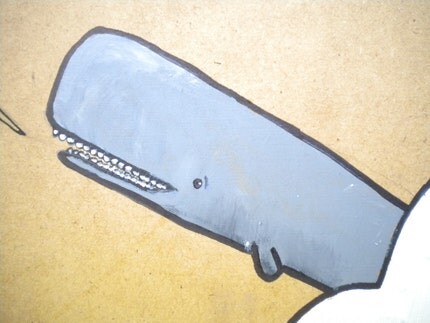I've typed and deleted this blog post three times now. I'm in a blog funk. A blunk. Or a flog. Whatever.
I'm having a hard time segueing into what I want to talk about. So I'll just start it this way:
Speaking of solo art shows...I got one! I have my first solo art show coming up in NYC. There's a little snag, though: I've sold all of my paintings. I guess that's not that big of a problem. I just have two months to come up with a series of paintings. Starting the first painting of a new series is terrible. I feel the compulsion to reformulate my entire theory on art and aesthetics with each new series. Maybe I just don't have the strength of character to have some overarching idea of what art should be.
Anyhow, I've been obsessed with bestiaries. No, not bestiality. Bestiaries. It's like a catalog of animals (and some trees and stones) made for really rich people in medieval times (not to be confused with the dinner theatre of the same name which is much more fun than the real deal). I've wasted many hours reading one that's been scanned and translated here.
Medieval people had some really wild ideas about animals. For example, they thought that when peacocks died their bodies would never decompose (if that were true wouldn't the world be filled with peacock corpses? It doesn't take a genius, medieval people), or that lions would reach down their throat with their paw to pull out food if they ate too much. They also thought that elephants, lions, tigers, and others all mated face to face (little known fact: the missionary position was originally called elephant style).
What makes bestiaries even more interesting is their spiritual nature. Medieval people thought that not only was the Bible the word of God but that the natural world, too, expressed the nature of God. Obviously, a lot of it is weird or silly because of inaccurate ideas of animals (there was no Jack Hannah in the 12th century). Okay, all of it is pretty silly, but nonetheless sort of poetic.
I thought the raven was interesting. The Aberdeen bestiary said that ravens will not feed their young until they see their black plumage. Apparently, their black plumage is supposed to represent the shroud of sin. Bad, right? Not exactly.
In one sense, it says that the bird can represent the devil. The ravens are known to first pluck out the eye of its prey, then eat it's brain. According to the bestiary, the devil and sin first blind a person to what's wicked, then devour their mind, that is, their way of thinking.
However, it then it says that the raven can also represent preachers. It says that preachers must first teach their parishioners of their sinful state and the need to repent before they can feed them spiritually. Like the raven that (supposedly) wouldn't feed it's young until it saw it's black feathers.
I thought this good/evil duality was really interesting. The raven didn't symbolize good or evil - it symbolized both. There are many examples of this throughout the bestiary. The owl represented the wicked sinner who rejected the light of truth and refused to leave the night of gross sin. But the night owl is supposed to also represent Jesus who willingly stayed in the darkness of a sinful world to save sinners. Again, the good/evil duality.
Ok, I'm done with the theology lesson. I thought this would be a good starting place for my new series. I decided I'd make a modern bestiary.
A modern bestiary would have to show a disconnect with nature, though. The modern world of production and consumption is usually at odds with (or at least indifferent to) the natural world. Even the "green movement" seems to be at odds with the natural world. It seems to be about being the environment's savior or doing as little damage as possible rather than realizing our place in it.
Also, whereas the old bestiaries were overtly spiritual, a modern one should be uncomfortably nihilistic. Not only nihilistic in the "I can't believe in God after what I've seen" sort of way. But also as Debord reffered to giving the modern spectacle the power that we formerly assigned to the devine. That is, a modern consumption culture nihlism.
Obviously (or obscurely), our view of the natural world and modern nihlism are connected. I won't explain how, though. Hopefully this new series will. I hope you like it.
What I listened to while typing: Caribou - Bees


Danny danny danny, As long as you are Danny , Your art will be interesting. With that said, send me a new letter, I need a pick me up.
ReplyDelete